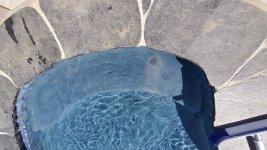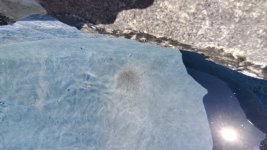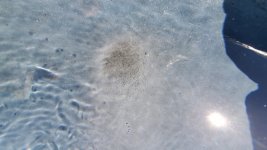So, my pool is a little over a month old. This morning I went out and glanced at the pool but didn't see anything wrong. By 2 pm when I went out to swim, I saw this spot on my front step. My plaster guy said it was caused by the "cynaric" acid in the chlorine tablets and says he tells all his customers not to use them. Well, actually the care and maintenance guidelines from him say don't use the floats because if pieces break off of the tablets and land on the plaster they can damage it. I brought this up to the maintenance guy when he proposed using the float and he said it'd be fine since the tablets just slowly dissolve. Since it's Memorial Day, I have to wait until tomorrow to talk to the pool maintenance company. I guess my question is who IS responsible for fixing this? Is this stain permanent and is there anything I can do to make it less noticeable?
Damage to new plaster caused by chlorine float
- Thread starter xtexan86
- Start date
You are using an out of date browser. It may not display this or other websites correctly.
You should upgrade or use an alternative browser.
You should upgrade or use an alternative browser.
- Aug 20, 2020
- 5,640
- Pool Size
- 27000
- Surface
- Plaster
- Chlorine
- Salt Water Generator
- SWG Type
- CircuPool RJ-60
The TFP method would have you not use the pucks (in a floater or otherwise) except in rare circumstances like a short vacation, etc because of several problems including excessive CYA buildup.
I’m not sure there’s any easy way to fix the stain, though it may become less obvious over time. Theres a bunch of helpful articles in this site that may help you decide to do your own pool maintainable instead of trusting service companies who probably mean well but don’t care as much about your pool as you do.

 www.troublefreepool.com
www.troublefreepool.com
I’m not sure there’s any easy way to fix the stain, though it may become less obvious over time. Theres a bunch of helpful articles in this site that may help you decide to do your own pool maintainable instead of trusting service companies who probably mean well but don’t care as much about your pool as you do.

ABC's of Pool Water Chemistry
There are several items things every pool owner should know about swimming pool water. We share details on the basics of Pool Water Chemistry.
Does the finish feel rougher in that spot? Do you know if any copper based algaecides were used since start up, or if the tablets contain copper? I'll ask an expert if they know anything that can help.
@onBalance
@onBalance
LoneWolfArcher
Bronze Supporter
Another reason to not use tablets! Switch to liquid chlorine and your pool maintenance will be so much better. (you should read the pool school articleshere in water chemistry).
As far as who is responsible, that's a tough one. I'm sure you feel it's the maintenance guy. The maintenance guy will probably try to say it is the plaster guys fault. I feel for you though considering it is a brand new pool.
As far as who is responsible, that's a tough one. I'm sure you feel it's the maintenance guy. The maintenance guy will probably try to say it is the plaster guys fault. I feel for you though considering it is a brand new pool.
Thanks, I will check out those articles eventually. I chose to go with a service because I didn't want to be the one responsible for doing something that would damage the new plaster...ha, well that didn't work! I also got a discount on the startup costs by agreeing to having the "professional" service for a few months....I figured that would give me time to learn how to monitor the chemicals myself.The TFP method would have you not use the pucks (in a floater or otherwise) except in rare circumstances like a short vacation, etc because of several problems including excessive CYA buildup.
I’m not sure there’s any easy way to fix the stain, though it may become less obvious over time. Theres a bunch of helpful articles in this site that may help you decide to do your own pool maintainable instead of trusting service companies who probably mean well but don’t care as much about your pool as you do.

ABC's of Pool Water Chemistry
There are several items things every pool owner should know about swimming pool water. We share details on the basics of Pool Water Chemistry.www.troublefreepool.com
It does appear that the spot was caused by a trichlor tab. The best thing is to try and sand the spot with 80 grit wet&dry sandpaper, which should remove the plaster that is damaged and expose good plaster underneath.
That being said, there may also be a second and future soon-to-be problem. It appears that the new plaster is somewhat blue, meaning that a color pigment was added to white cement and is now blue. Well, many blue pigments soon bleach out, due to a continuous chlorine residual as is normal. If there was also a gray pigment added (along with the blue), making it a blue-gray color, then the blue color will disappear and leave the plaster a simple gray color.
That being said, there may also be a second and future soon-to-be problem. It appears that the new plaster is somewhat blue, meaning that a color pigment was added to white cement and is now blue. Well, many blue pigments soon bleach out, due to a continuous chlorine residual as is normal. If there was also a gray pigment added (along with the blue), making it a blue-gray color, then the blue color will disappear and leave the plaster a simple gray color.
Shirker
0
- Jul 2, 2014
- 749
- Pool Size
- 19000
- Surface
- Vinyl
- Chlorine
- Salt Water Generator
- SWG Type
- Pentair Intellichlor IC-40
I believe it is very probable that pucks did cause the damage. You likely will not have any recourse from the plaster guy unless he is just extraordinarily generous. And unless the maintenance company is willing to help you, it will likely cost you more time/money than it is worth pursuing them.I guess my question is who IS responsible for fixing this?
My Recommendations:
1.) Fire the maintenance company and manage your own pool. It really is not that much time/work per week if you use this site.
2.) Be very nice to the plaster guy and see what recommendation he has on what it would take to get it fixed. Post his recommendations here and see what the experts here think about them.
No, I wouldn't say it feels rougher. I'm very surprised that whatever acid or chemical caused the stain, was strong enough to expose the black aggregate in the plaster. Plaster guy thinks it may eventually go away, but I honestly don't see how that's going to happen given, again, that you can see so much of the exposed aggregate. I wonder if placing a small tile mosaic on that spot would be a good way to cover up the damage? It wouldn't have to be flush with the plaster surface but I'd rather look at that than this spot for the next several years!Does the finish feel rougher in that spot? Do you know if any copper based algaecides were used since start up, or if the tablets contain copper? I'll ask an expert if they know anything that can help.
@onBalance
- Jun 1, 2018
- 13,587
- Pool Size
- 26000
- Surface
- Vinyl
- Chlorine
- Salt Water Generator
- SWG Type
- Hayward Aqua Rite (T-15)
This is the same type of thing that always happens to me when I pay for a service I can perform myself but go out on a limb & part it out. I generally end up dissatisfied & obviously with a lighter wallet, lesson learned  .
.
Sorry this happened to your pretty new pool - I know it’s disheartening.
Hopefully someone will do their best to correct it for u. But if not the folks around here will definitely help u make it less noticeable.
Sorry this happened to your pretty new pool - I know it’s disheartening.
Hopefully someone will do their best to correct it for u. But if not the folks around here will definitely help u make it less noticeable.
I'll see what the maintenance supervisor has to say, hopefully that'll be today. I was thinking if the stain doesn't eventually dissolve if placing a small tile mosaic on top would be a preferable option? I've posed that question to the plaster guy so will see what he says.I believe it is very probable that pucks did cause the damage. You likely will not have any recourse from the plaster guy unless he is just extraordinarily generous. And unless the maintenance company is willing to help you, it will likely cost you more time/money than it is worth pursuing them.
My Recommendations:
1.) Fire the maintenance company and manage your own pool. It really is not that much time/work per week if you use this site.
2.) Be very nice to the plaster guy and see what recommendation he has on what it would take to get it fixed. Post his recommendations here and see what the experts here think about them.
Pool ownership is very new to me and with everything I have going on, it was not a good time to learn about pool chemistry. I also didn't want to do anything out of ignorance that would damage or impact the warranty on the new plaster...ha, well that didn't work! As far as making it less noticeable, what suggestions do you have? I'm considering placing a small tile mosaic on top of the step...it wouldn't have to be flush with the plaster surface, but better to look at than the stain!This is the same type of thing that always happens to me when I pay for a service I can perform myself but go out on a limb & part it out. I generally end up dissatisfied & obviously with a lighter wallet, lesson learned.
Sorry this happened to your pretty new pool - I know it’s disheartening.
Hopefully someone will do their best to correct it for u. But if not the folks around here will definitely help u make it less noticeable.
- Jun 1, 2018
- 13,587
- Pool Size
- 26000
- Surface
- Vinyl
- Chlorine
- Salt Water Generator
- SWG Type
- Hayward Aqua Rite (T-15)
With time/ reading here you will get a good understanding of the chemistry & maintenance requirements of your pool. The whole premise of TFPC is that you (the owner) are the one who cares the most deeply about your pool (unlike service providers) as you have unfortunately experienced. I will let the others guide you on solutions for your current situation as they are definitely better versed in plaster pools than I.
I just wanted to give u a little encouragement that you can definitely handle your pool care & that answers/advice are only a click away here so do not be discouraged.
I just wanted to give u a little encouragement that you can definitely handle your pool care & that answers/advice are only a click away here so do not be discouraged.
That's an interesting subject. I've never run across anything online that talks about blue coloring disappearing in plaster. Mine was done in DiamondBrite and the color was Manzanitta Medium. There is some grey mixed in as the color is a result of combining 2 other colors. The maintenance guy did mention something about how darker blue plaster will tend to fade a little, but it takes many years for that to happen. I've also thought about using the sandpaper, but you say it'll expose the good plaster underneath...I hope so but is there a chance it'll also expose more of the black aggregate or does the sandpaper remove that also?It does appear that the spot was caused by a trichlor tab. The best thing is to try and sand the spot with 80 grit wet&dry sandpaper, which should remove the plaster that is damaged and expose good plaster underneath.
That being said, there may also be a second and future soon-to-be problem. It appears that the new plaster is somewhat blue, meaning that a color pigment was added to white cement and is now blue. Well, many blue pigments soon bleach out, due to a continuous chlorine residual as is normal. If there was also a gray pigment added (along with the blue), making it a blue-gray color, then the blue color will disappear and leave the plaster a simple gray color.
Shirker
0
- Jul 2, 2014
- 749
- Pool Size
- 19000
- Surface
- Vinyl
- Chlorine
- Salt Water Generator
- SWG Type
- Pentair Intellichlor IC-40
It is intimidating. But there is only a few things you really need.I have going on, it was not a good time to learn about pool chemistry. I also didn't want to do anything out of ignorance that would damage or impact the warranty on the new plaster
1.) This site is wonderful. Fill out your signature to include your pool size, the fact that it is plaster, the type of filter, and the test kit you use. This will help people give you more tailored advise.
2.) Make sure you have one of the recommended test kits Test Kits Compared.
3.) Stay out of the pool store. Their recommendations don't always play well with the TFP method. The TFP method is all about understanding what and why something is added to the water and only adding stuff that actually needs to be added. No magic potions. If there is something you don't understand or are curious about, post it here and this community will point you in the right direction.
Thanks, I'm sure it's something I can eventually learn, just had too much going on once the pool (a year-long project as an owner-builder) was done. I also didn't want my ignorance of how to chemically start up a new pool interfere with the warranty on the plaster since it seems many of the plaster manufacturers require a professional do the start up.With time/ reading here you will get a good understanding of the chemistry & maintenance requirements of your pool. The whole premise of TFPC is that you (the owner) are the one who cares the most deeply about your pool (unlike service providers) as you have unfortunately experienced. I will let the others guide you on solutions for your current situation as they are definitely better versed in plaster pools than I.
I just wanted to give u a little encouragement that you can definitely handle your pool care & that answers/advice are only a click away here so do not be discouraged.
Shirker
0
- Jul 2, 2014
- 749
- Pool Size
- 19000
- Surface
- Vinyl
- Chlorine
- Salt Water Generator
- SWG Type
- Pentair Intellichlor IC-40
I'm not sure how well you would be able to get a tile to stick to the surface of the plaster. It might work? Maybe someone with more experience will have some advise on that. But I would not do it yet. Wait and see if the spot can be repaired first.I was thinking if the stain doesn't eventually dissolve if placing a small tile mosaic on top would be a preferable option?
They would probably need to cut and remove plaster to inset the tile. Just having it on top of the plaster may cause it to be knocked off or possibly cut or scratch skin and snag swimwear.
LoneWolfArcher
Bronze Supporter
Thanks, I'm sure it's something I can eventually learn, just had too much going on once the pool (a year-long project as an owner-builder) was done. I also didn't want my ignorance of how to chemically start up a new pool interfere with the warranty on the plaster since it seems many of the plaster manufacturers require a professional do the start up.
When we bought this house with the pool, I was just like you. I wanted as little maintenance as possible. I grew up with an AG pool and watched my dad spend hours a day maintaining and vacuuming the pool. Draining and refilling it. My attitude was "that is not for me!"
So I used all of the shortcuts I could: stabilized chlorine pucks, magic potions to fight algae and clear the water. Etc. By the end of the first summer I hated my pool. Due to the stabilized chlorine pucks I ended up with really high CYA (the stabilizer that comes in the pucks and never decreases, only increases). And because I had high CYA I was throwing algaecide into my pool to fight the algae (because with high CYA chlorine couldn't do it!). I ended up turning my pool purple! (Copper Cyanurite as a result of the algaecide (copper) and Cyanuric Acid (chlorine stabilizer). I hated my pool.
The next spring I found TFP! Got a proper test kit. And learned to use liquid chlorine only, muriatic acid to lower Ph, baking soda or borax to increase Ph, and CYA when needed and that was it! I now love my pool! I got a robotic pool vacuum this year and now my pool maintenance is even simpler!
Best part, I am spending a fraction of what I did that first summer when I was chasing problems. The lesson I learned was that spending 10-15 minutes a day testing my water and adding LC saved me hours of aggravation down the line. In other words, the shortcuts so I could skip maintaining my pool ended up costing me time and headaches down the line.
So consider that, pool services are expensive. A good robot vacuum will be a better investment since once you get the hang of the maintenance that part is a piece of cake.
You're correct...the plaster guy said the mosaic could be cut into the existing plaster.They would probably need to cut and remove plaster to inset the tile. Just having it on top of the plaster may cause it to be knocked off or possibly cut or scratch skin and snag swimwear.
Thread Status
Hello , This thread has been inactive for over 60 days. New postings here are unlikely to be seen or responded to by other members. For better visibility, consider Starting A New Thread.




